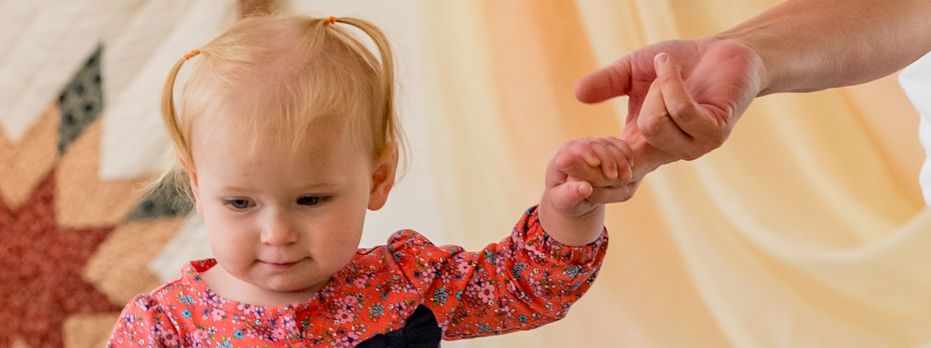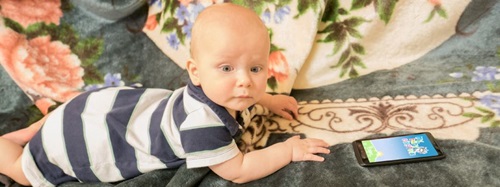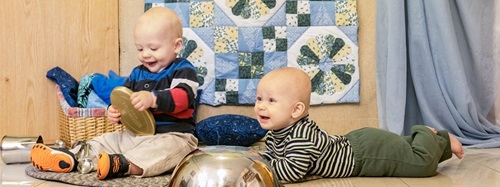Infants Have Their Own Curriculum
A Responsive Approach to Curriculum Planning for Infants and Toddlers
| July 2005Infant-toddler programs often look like either watered-down versions of preschool or glorified versions of baby-sitting. Unfortunately, most of the curriculum approaches and lesson plans that program managers require don't necessarily improve practice.
In infant-toddler programming, what is usually seen is the implementation of curriculum extremes. For example, one common curriculum approach is based on the belief that very young children need only safe environments and tender loving care and that specific attention to learning is inappropriate. Another even more common approach is based on the belief that in order for infants and toddlers to grow and develop cognitively they must be stimulated intellectually by adult-developed and -directed lessons and activities, carefully planned ahead of time and programmed into the child's day. Both of these positions are based on a lack of true understanding of infant-toddler development.
In high-quality infant-toddler programs, the interests of the child and the belief that each child has a curriculum are what drive practice. It is understood that very young children need to play a significant role in selecting their learning experiences, materials, and content. Curriculum plans, therefore, do not focus on games, tasks, or activities, but on how to best create a social, emotional, and intellectual climate that supports child-initiated and child-pursued learning and the building and sustaining of positive relationships among adults and children.
Planning a Responsive Approach to Curriculum Development and Implementation
Responsive curriculum planning focuses on finding strategies to help infant-toddler teachers search for, support, and keep alive children's internal motivation to learn, and their spontaneous explorations of people and things of interest and importance to them. This should begin with study of the specific children in care. Detailed records of each child's interests and skills are kept to give guidance to the adults for the roles they will take in each child's learning. It should also be realized from the start that plans should not be static. Adaptation and change are critical parts of the learning process and should be anticipated. Once an interaction with a child or small cluster of children begins, the teacher has to be ready to adapt his or her plans and actions to meet the "momentary" needs and interests of each child.
Appropriately developed plans are strategies to broaden the caregiver's understanding of, and deepen their relationship with, each child and family. Good planning should:
- reflect activities that orient the caregiver to the role of facilitator of learning rather than the role of "director" of learning;
- assist the caregiver in reading the cues of each child; and
- prepare the teacher or home visitor to communicate effectively with other adults in the child's life. Another essential component of planning is attention to a responsive learning environment and specific attention to how environments should be changed. The planning of learning environments is more important to infant-toddler development than specific lessons or specific activities. The environment must be seen as part of the curriculum, creating interest and encouraging and supporting exploration. Research has shown that much of how infants and toddlers learn best comes not from specific adult-directed lessons but from teachers knowing how to maximize opportunities for each child to use natural learning inclinations.
Selecting or Developing a Curriculum for Infants and Toddlers
From all we know about how infants and toddlers learn best, we know that they must have a hand in selecting what they learn. Therefore, the infant or toddler should be an active partner in the process of "selecting" curriculum content. The curriculum should be dynamic enough to move and flow on a daily basis with the infant's developing interests and changing needs. In this way, the curriculum is responsive and respectful of what the children bring to and want from these early experiences.
A general point of caution: Do not select a curriculum or planning format that is simply a prescribed sequence of adult-initiated and -directed activities that leaves the child out of the process of selecting what is focused on and pursued. Both the child and the caregiver should play a role in the selection process, with the child initiating the activity at times and the caregiver at other times.
Curriculum planning, implementation, and supportive materials should anticipate developmental stages and allow for individual variations in learning styles and temperaments. These aspects of curriculum must be broad enough in scope to respond to all developmental domains simultaneously.
Responsive Curriculum
In a responsive curriculum, implementation of subsequent planning has to do with caregivers preparing themselves and the environment so that infants and toddlers can learn–not in figuring out what to teach children. "Lesson planning" involves exploring ways to help caregivers get "in tune" with each infant-toddler they serve and learn from the individual child what he or she needs, thinks, and feels. Even "in-tune" teachers need to plan and replan how to form a relationship with each infant-toddler to best meet the child's needs and relate to the child's unique thoughts and feelings. Very little positive learning will take place, regardless of what daily plans look like, if the curriculum and planning do not include:
- Grounding caregivers in the family culture, and in the cognitive, social, and emotional experiences in which infants and toddlers are naturally interested;
- Developing a safe and interesting place for learning;
- Establishing small groups for learning and care;
- Selecting materials appropriate for the individual needs and interests of the children served;
- Optimizing program connections with the child's family; and
- Establishing management policies that support the child's need for security in care and continuity of connection with the caregivers.
Specific Factors to Consider When Developing An Infant-Toddler Curriculum
- Infancy has three stages. Between birth and age three, a child goes through three distinct developmental stages: young infant, mobile infant, and toddler. The type of care and experiences given should change when the child's stage changes and should also take into consideration transitions between stages.
- Infants learn holistically. Infants do not experience social, emotional, intellectual, language, and physical learning separately. Adults are most helpful to the young child when they interact in ways that reflect an understanding of the fact that the child is learning from the whole experience, not just the part of the experience that the adult gives attention.
- Relationships are primary for development. The infant is dependent on close, caring, ongoing relationships for positive physical, social, emotional, and intellectual growth. Infants develop best when they are sure of having trusted caregivers who can read their cues and respond to their needs.
- Infants are developing their first sense of self through contact with others. An infant or toddler learns most of how he or she thinks and feels by imitating and incorporating the behaviors of those who care for her or him–how they first see themselves, how they think they should function, how they expect others to function in relation to them.
- Home culture is an important part of a child's developing identity. Because an infant's sense of self is such a crucial part of a child's make-up, early care must ensure that links with family, home culture, and home language are a central part of program policy.
- Infants are active, self-motivated learners. Environments and activities that keep motivation, experimentation, and curiosity alive must be constructed to facilitate the infant learning process.
- Infants are not all alike–they are individuals with unique temperaments. Because of these differences, staff needs to individualize and adapt to each child.
- Language skills and habits develop early. The development of language is particularly crucial during the infant-toddler period. Quality care provides many opportunities for infants to engage in meaningful, experience-based communication with their caregivers, and have their communications acknowledged and encouraged.
- Environments are powerful. Infants and toddlers are strongly influenced by the environments and routines they experience each day. This is particularly true for very young infants who cannot move themselves from one environment to another. The physical environment, group size, daily schedules, plans, and routines must foster the establishment of small intimate groups in which relationships with trusted caregivers can develop.
- Adults exhibit strong emotions and opinions when entrusted with the care of infants. Parents and caregivers of infants and toddlers often experience heightened emotions about how to care for infants and toddlers. Strategies for dealing with conflicts that may emerge between parents and staff must be considered by each program.






